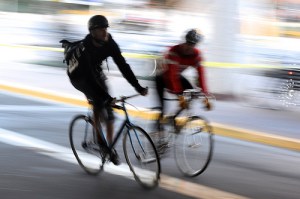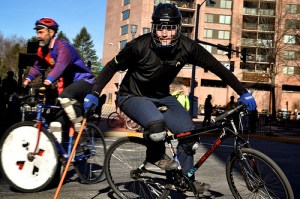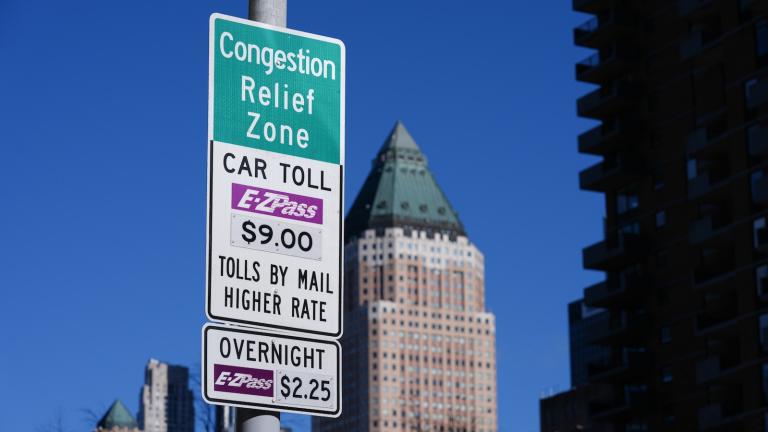
Photo by M. V. Jantzen.
It was the classic test of a longstanding question: Who is the supreme cyclist, bike messenger or road racer?
The field had winnowed to just two riders in the final race of the Diamond Derby, a daylong bicycling event in Northern Virginia just across the Potomac from Washington, D.C. Road racer Michael Esmonde, all Lycra-clad and riding a high-end carbon fiber speed machine, faced down bike messenger Sean O’Donnell, who sported just a cotton T-shirt and cutoff jeans while pedaling a well-worn fixed-gear bike.
Almost as interesting as the matchup between the two bicycling worlds was the event’s location: a parking garage. The Diamond Derby was more than just a bike race. It was part group ride (costumes encouraged), part bike polo tournament — and part gonzo racing spectacle, where the assembled crowd could sip adult beverages and watch the contests from the comfort of a temporary lounge complete with sofas, tables, and bar stools, and featuring the works of a dozens of local artists.
It was an event designed to create both competition and camaraderie — the kind of colorful, underground art/sport experience that has become a signature of this country’s ever evolving urban cycling culture. It was a day for all: racers and non-racers, cyclists young and old, and activities for the competitive riders and the “just for fun” types as well.

Photo by M. V. Jantzen.
The event was a partnership between the Crystal City Business Improvement District, which promotes Arlington’s downtown area, and local businesspeople, bicyclists, and promoters. (Other events in the area include the summer Seersucker Social and the fall Tweed Ride, which features riders wearing attire more appropriate for ballroom dancing than a bicycle ride.) A percentage of the proceeds from the Diamond Derby would help pay the medical bills for Chris Soda, a Washington, D.C., bike messenger who had suffered serious head trauma in a training accident.
The races themselves, which wound through a maze of concrete pillars, hay bales, and other obstacles, combined elements of cyclocross and bike messenger races. Originally intended as off-season winter training for road racers, cyclocross has become the fastest growing segment of bike racing. Cyclocross races are often held in urban parks, and require riders to navigate obstacles such as mud pits, cobblestone paths, staircases, and tight S-turns on grass or packed earth. A series of short, fast loops—and the potential for some spectacular wipeouts—make it a great spectator sport.
Bicycle messengers have their own contests called Alley Cat races. These races often mimic the day job of the bicycle courier by giving racers a “manifest” where they have to ride their bikes to various check points around the city. Alley Cat races tend to be unsanctioned events, held on city streets where the racers have to factor in the risks and dangers of traffic. The pinnacle of all Alley Cat races is the World Messenger Championship, a wild, three-day event to be held in Chicago this summer.

Photo by M. V. Jantzen.
The Diamond Derby was a gonzo mash-up of these two styles set in a landscape more reminiscent of roller derby than a bike race. The course was a short, winding loop punctuated with hay bales and stacks of old mountain bike tires to force racers to either dismount and carry their bikes, or bunny hop over the barriers. There was an “open” category race, a kids’ race, a four-person relay, a 30-minute-plus-one-lap race — and the grand finale, known as the Four X Comp, that pitted Michael Esmonde, the road racer, against Sean O’Donnell, the bike messenger.
So who would come out on top?
It was dizzying to see the lead racers attack the course. Esmonde was hammering the 1.5-kilometer (0.9-mile) loop with an amazing mix of muscle and finesse. O’Donnell was chasing aggressively just a few yards behind, despite working with just one gear and no free-wheel. This game of chase had Esmonde acting as the carrot for the full duration of the race.
In the end, Esmonde held his lead, blazing across the finish line first, with O’Donnell not far behind. On this day it was road racer over bicycle messenger. It was racing at its highest level, with each representative of opposing subculture gaining the respect of the other.
But while the showdown in the elite event was exhilarating, it was the the open race that really captured the spirit of the day. This race added yet another twist to the course by throwing in a messenger-esque scavenger hunt aspect, where racers could score points by tossing U-locks through hoops, delivering packages to various locations along the course, and picking up and replacing rolls of tape looped over the tops of orange safety cones. It was a great mix of heavy breathing and smiles.

Photo by M. V. Jantzen.
At the sound of the gun in the open race, a man in his team road-racing kit took off fast and opened a gap on the field, while an assortment of riders on a wide variety of bikes chased along. Trailing far behind was a father-daughter team on an old yellow Schwinn tandem, wearing matching red wool coats. As the road racer lapped the field, this duo meandered through the course at a leisurely pace, pausing at nearly every checkpoint, never pedaling fast enough to break a sweat. When the race was over and the points where tallied, the slow-moving tandem, with all its extra points, finished first — in the classic “Tortoise and the Hare” style.
The Diamond Derby was not only a day of adrenaline-fueled racing. It was a glorious day for all, young and old, newcomers and old-timers — a wide variety of people who share a common interest in bikes, and an appreciation for the community-building power of pedal-powered recreation.



